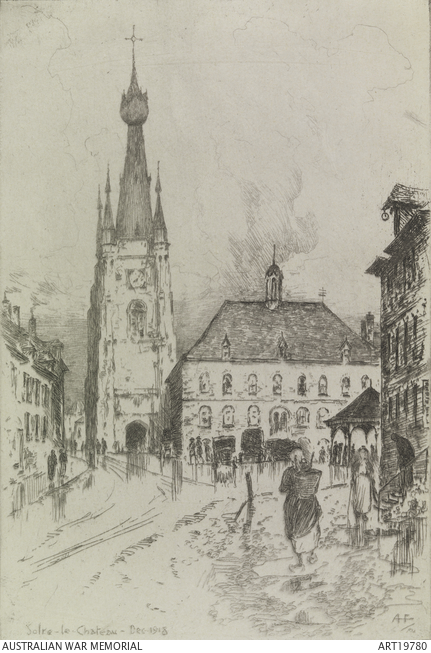| Places | |
|---|---|
| Accession Number | ART19780 |
| Collection type | Art |
| Measurement | sheet: 25.8 x 20.2 cm; plate: 22.5 x 15.1 cm |
| Object type | |
| Physical description | etching in black ink on paper |
| Maker |
Fullwood, A Henry |
| Place made | Australia: New South Wales, Sydney |
| Date made | 1924 |
| Conflict |
First World War, 1914-1918 |
| Copyright |
Item copyright: Copyright expired - public domain
|
Solre-le-Chateau

Depicts the liberated town of Solre-le-Chateau after the armistice. The image depicts the town square with the Church bell tower and town hall in the background with the towns inhabitants attempting to return to normal life. Solre-le-Chateau was the headquarters of 5th Australian Division, Australian Imperial Force in late 1918. Albert Henry Fullwood was born in Birmingham, England in March 1863. In 1883 he sailed to Australia and began work as a lithographic draughtsman , working on the staff of illustrated journals such as 'Australian Town and Country Journal' and the 'Bulletin'. In 1900 he went to the United States, then to London, as an expatriate artist where he worked as a freelance illustrator, receiving commissions from newspapers and journals, including the London 'Graphic' and designing postcards. From April 1915 until November 1917 Fullwood served with the Royal Army Medical Corps as an orderly at the 3rd London General Hospital at Wandsworth in the company of fellow artists Coates, Roberts and Streeton. He was subsequently appointed an official war artist , attached to the 5th Division AIF, working in France between May and August 1918 and from December 1918 to January 1919. His major contribution as a war artist was to record aspects of the war which others may not have noticed or taken for granted. His works have a narrative element and captured Australian soldiers in 'straightforwardly picturesque views of their environment'. Fullwood returned to Australia in 1920 after his commission had been terminated and became a foundation member of the Australian Painter Etcher's Society in 1920 and the Australian Watercolour Institute in 1924. He died from pneumonia in October 1930.
